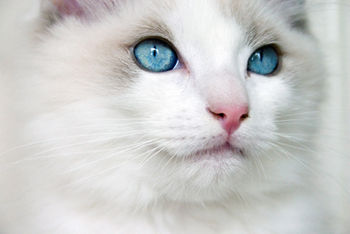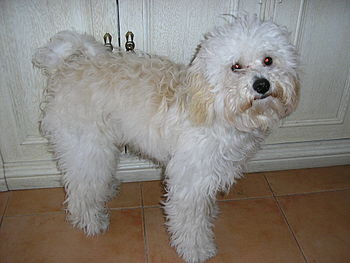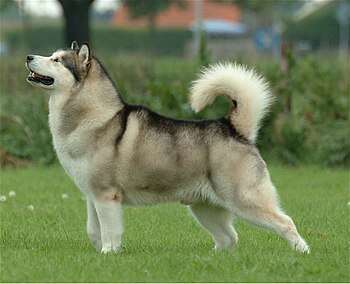When you think about getting a dog for a loving, best-friend pet, have you thought about a Poodle? Poodles have much more than just great looks. They are smart, affectionate, great with children and so devoted. Poodles are extremely people oriented. In fact, they do not do well without human companionship. Poodles are also friendly with other dogs and non-canine pets. They are very loving and loyal and will defend their home and people with their lives when threatened.
 |
| A silver Miniature Poodle stacked. (Photo credit: Wikipedia) |
Poodles are sensitive to their owner's emotions, ready to be your best friend and quietly sit by your side when you are sad or equally ready to go play ball when you're happy. Poodles are clowns and prance around with a toy or a dog biscuit in their mouths to greet you or to play with you. Above all, Poodles think they are human. They love their owners faithfully and want to be with them.
Many people think that Poodles originated in Germany. The name "Poodle" comes from the German word "Pudel," which is short for "Pudelhund," which means "splashing dog". Others are certain that the Poodle is actually descended from a now nearly extinct French water dog, the Barbet and possibly the Hungarian Water Hound. These dogs have a very long history. Poodles are depicted in 15th century paintings and in bas-reliefs from the 1st century. They were used extensively throughout Europe through the ages for retrieving game, (especially in the water.) Toy Poodles became royal favorites, particularly in the 18th century.
Poodles come in three recognized sizes, the Standard Poodle being the largest, the Miniature Poodle and the Toy Poodle (the smallest). Toy, miniature, and standard Poodles are distinguished by adult shoulder height. Toy Poodles are 10 inches or under at the highest point of the shoulder, and typically weigh less than 12 pounds. Miniature Poodles are taller than 10 inches and up to 15 inches at the highest point of the shoulder. For those who prefer a large dog, Standard Poodles are over 15" at the shoulder, with some reaching as much as 30" at the shoulder. "Standard" Poodles (the big ones) are usually between 45-60 pounds (Female) and 65-80 pounds (Male. Other designations, like the "Royal Poodle" on the large end of the spectrum, and the "Tiny Toy" and "Teacup" are not officially recognized sizes, but are used for convenience and descriptive purposes. Among the Toy Poodles, most breeders say "Tiny Toy Poodles" are 4 to 5 pounds, "Teacup Poodles" are 2 to 4 pounds, and the regular Toy Poodle is 5 to 8 pounds at maturity.
They are fairly healthy dogs. For example, in Miniature Poodles, the leading cause of death is old age (39%). They have relatively long life spans. and live anywhere from 12 to more than 15 years. As a general rule, smaller dogs have a longer life span than larger dogs, and accordingly, a healthy Standard Poodle may live as long as 14 years, and the smaller varieties longer.
Ear infections are a problem in all Poodle varieties, but ear problems can be minimized by proper ear care and regular grooming. Healthy Poodle ears should be cleaned on a regular basis, and so should the area around their eyes. Along with ear and eye care, your Poodle will need her teeth brushed and her nails trimmed. Poodles do require dental care as they are generally known to develop serious dental problems as they age.
Poodles come in many colors including black, white, red, apricot, silver, and brown. Because they don't shed Standard Poodles do need grooming regularly. We think of Poodles in elaborate grooming cuts, and we may see some like this on pictures, or shows. But, most pet Poodle owners keep their Poodles in much simpler cuts that are easier to care for and require less grooming.
You may seek a newborn Poodle puppy, or an adult. It is great to rescue an unwanted Poodle from a shelter, as they are generally so good natured and behaved. For some unknown reason, many people seem to want to adopt female Poodles. There is really no logical reason for this, as male Poodles are just as smart, attentive, and well behaved as the females. Most Poodles that end up in rescue centers are male and are usually over five years old.
Regardless of when or where you get a Poodle, you will find that you are truly adding a new family member. And one who thinks of himself or herself as a family member, just another person, like everyone else. Poodles are are wonderful with children as they love to play and do many silly things just as kids do. And adults will love this quality in the Poodle, too. Poodles are wonderful family and personal Pets, that will bring you many years of fun and constant companionship.
Get the best step by step plan for your online affiliate business internet marketing promotion [http://affiliatedominator.info]. Follow the steps in this report and you will dominate the search engines quickly in your niche - and for free!
Article Source: EzineArticles |

















